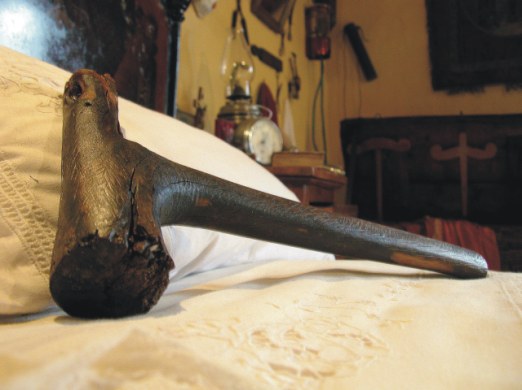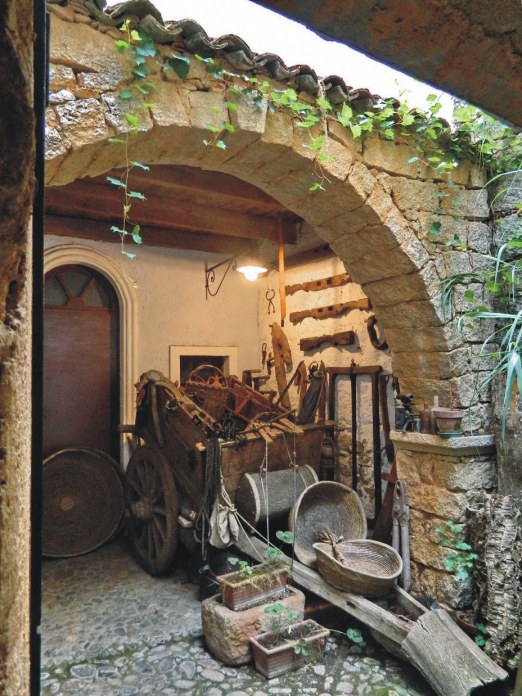The last hammer of the "Femina Agabbadora"
The museum of the traditional ritual of euthanasia
The femina accabbadòra or femina agabbadòra literally is the one who hits. The Sardinian word "acabu", finish, is a term clearly derived from Spanish: "acabar" that means literally "hitting on the head."
A clear word through a gesture as much eloquently to give the finish on the head, an act that encloses unequivocally the function of this mysterious and emblematic figure.
It places itself in the groove of the existence, between life and death, under an aspect of the first order, to say the least, surprising: the woman who gave death, also gave
life, because as there was s'accabbadora who helped to die, there was against the midwife who helped to born. And it was the same person.
This opposite and contrasted dualistic aspect of giving life and death, would be enough to distinguish, in a dignified manner, one of the most controversial and impenetrable symbols of Sardinian old times; a past not too far away.
Around this archaic form of euthanasia, lately, it has been written and said a lot, it has been discussed the social role that this ambivalent symbol has had, the veil of secrecy and silence that has always hovered around its name and the halo of mystery that constantly has wrapped its last fatal act.
The line between life and death is very thin, when the sick person tired and suffering awaits its hour. But in all this there is something deeper, more intimate, more real. This woman, mind you, not kill, but gave the death (putting an end to the suffering).
In Luras there is an amazing place that, as well as interesting exhibits of the culture and traditions of Sardinia, holds a hammer of the femina agabbadora, the tool used to give the longed death to the dying sick person.
Pier Giacomo Pala, owner of the museum Galluras, which houses the famous hammer, has devoted thirty years of study to this figure and wrote a book titled - Anthology of Femina agabbadora - where he says, among other things, as he has discovered this incredible finding.
This story is primarily the story of a stubborn and arduous search, lasted years, and an incredible and unexpected discovery.
"I waited so long, perhaps too much, someone to help me to write down, put in order and edit the collection of the material, which, over the years, I could find about the femina agabbadora.

The meeting with Ghjuanni Maria
"With my close friend tiu Ghjuanni Maria, Mr. Giovanni Maria, I would often go for walks in the countryside. During one of them, he told me that when he was a child, his grandfather had told him about a woman, in the countryside of Luras, that using a wooden hammer, helped the dying to die.
At the time the news leaved me indifferent but, at night, I thought that behind that information can hide something very fascinating and important.
The next morning I went to tiu Ghjuanni Maria to ask details about the news that had given me the day before: disappointment. He replied that he did not remember more, beyond what he said because at the time he was a child; he confirmed what he had already said, adding that he remembered very well, as if he had been told by a few minutes. "
The research
"From that time I started the investigation, interviewing the elders of my village; no one has ever heard of that practice.
I went, then, in search of the sheep pen, where the woman had lived who, supposedly, helped people to die. Everything seemed impossible, no one could give me information or directions.
I did not throw in the sponge, I persevered in asking, I began to document and finally some good news: the women who helped to die, sas feminas agabbadòras, were also "sas mastras de paltu," or midwives or obstetrician.
I kept on to interview the elders of my village and I began to check in every corner, millimeter by millimeter, of the pens in the area looking for the hammer of the femina agabbadora, realizing immediately that the research was not easy, no signal, in fact, helped me.
My focus, increasingly, went on the documents, texts and especially on the books of the nineteenth century travelers who visited Sardinia. Months and years passed by.

The find
"There comes, so, the year 1993 and I was passing, for the umpteenth time, near one of the pens I had already inspected.
There were works in progress to demolish a dry stone wall. I got closer to understand. A few meters of the wall were to be demolished. It saddens me a bit to see that another sign of the past will be deleted. I was about to go away when I saw a stone wall that makes me curious because it was different from the others.
It was regularly shaped, rectangular, while the others were irregular in shape, as in all dry walls made of granite. I got closer and I saw that at the top of the stone is stuck a small wedge, always granite. I pull out the wedge and the stone falls. It closed a niche; inside a wooden hammer and small fragments of black woolen fabric. What I looked for twelve years, I finally found. I took it and ran away.
I was excited, happy, happy.
Only ten minutes later I saw what has been achieved. The dream that I pursued for many years came true. "
Pier Giacomo speaks emphatically, with passion. An object that gived death that looked lost and forgotten, before hided in the dark belly of a wall, now is in the middle of a bright light on a bed in his museum.
But they were all so the tools used by these women to give death?
Pier Giacomo says no. "The tool used by the femina agabbadora, to finish the suffering of the terminally ill people, had a different shape depending on the area. A form of hammer was typical and exclusive of Gallura. In other areas of Sardinia it was in the form of a simple stick, called "mazzoccu" in Nuoro, or "mazzoca" in Campidano. In a witness I have gathered in Cuglieri told about tool shaped like a big mortar pestle, the length of about thirty centimeters. Oddly there is a hammer shaped ones in France, where it was called "the blessed hammer " and was preserved in churches. Some French scholars argue that priests were using the hammer. This certifies that we are faced with a practice also recognized by the French church ".
Finally, Pier Giacomo talks about his museum and as the number of visitors has grown over the years.
"Galluras The museum opens to the public in June 1996. The first year he recorded the presence of seventy visitors, an amount that doubled from year to year, reaching the current five thousand appearances. For a small village with less than three thousand inhabitants it is definitely a tourist attraction of great importance if we consider that, before the opening of the museum Galluras, in Luras arrived annually about twenty tourists and this was not the will of the tourists themselves, but because the road signs was almost nonexistent and they came because wrong road.
One can cite a few examples which are not numerically significant, but certainly are illustrative and significant attractive force of the museum.
About ten years ago came to the museum Galluras a visitor, an anthropologist of Palma, who told me he had bought a Sardinia holiday package because he was interested to see and touch the hammer of the femina agabbadora.
In 2011 two American tourists, precisely from Washington, say they arrived in Sardinia to visit the museum for the same reason. In recent years more and more visitors coming to the museum because interested in the subject and attracted to this figure. "
A wonderful place then, that revolves around one of the most elusive and indecipherable in Sardinian history; an image that contained in a few seconds and in one gesture, the unique and profound relationship our ancestors had with death. Then a book, study and research, suffered and lived.
And finally a solitary object, loaded with conflicting values, full of charm, an immortal tool, through which terminal ills were not killed and deprived, but only were freed; in other words: it gave death.
MUSEO ETNOGRAFICO GALLURAS:
"Il Museo della Femina Agabbadòra "
Via Nazionale 35/a - 07025 - Luras (OT)
Tel: (+39) 368 3376321